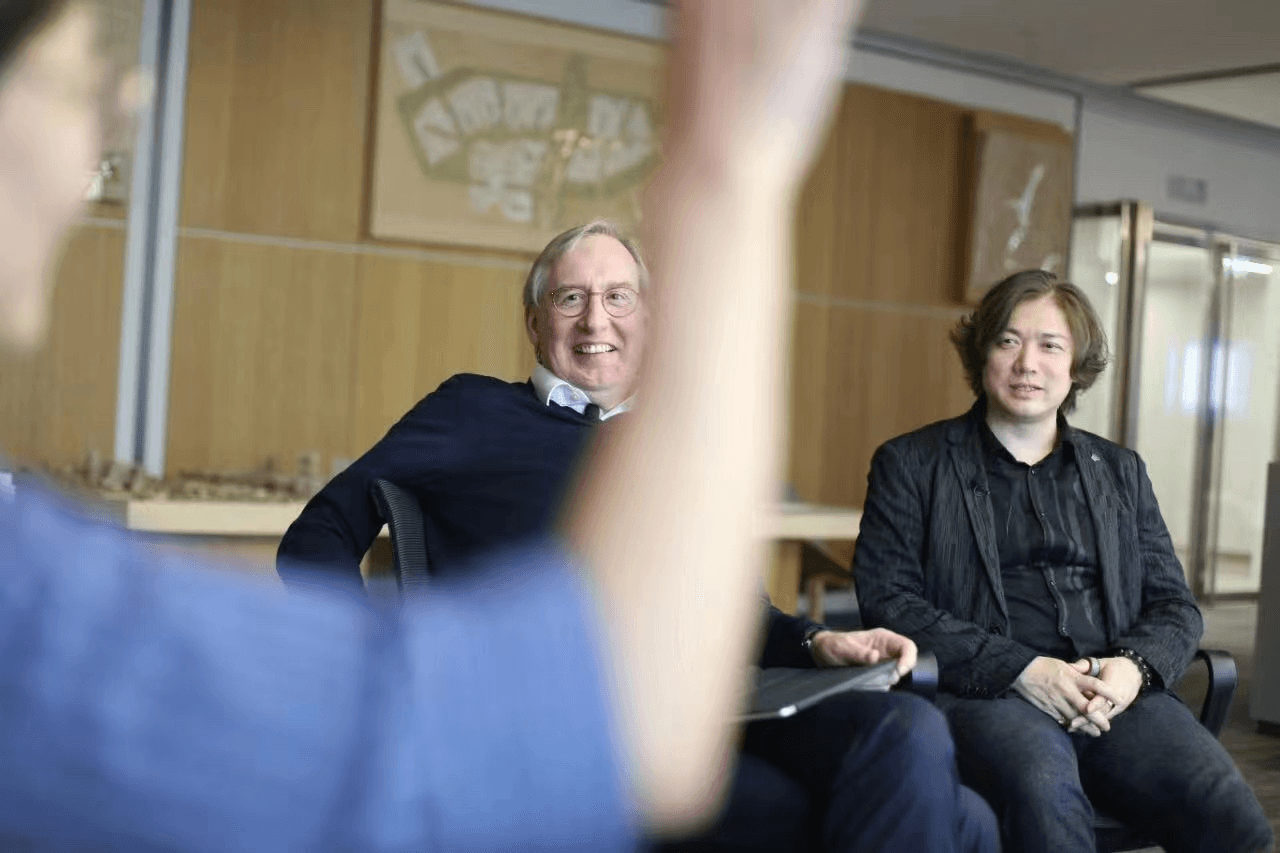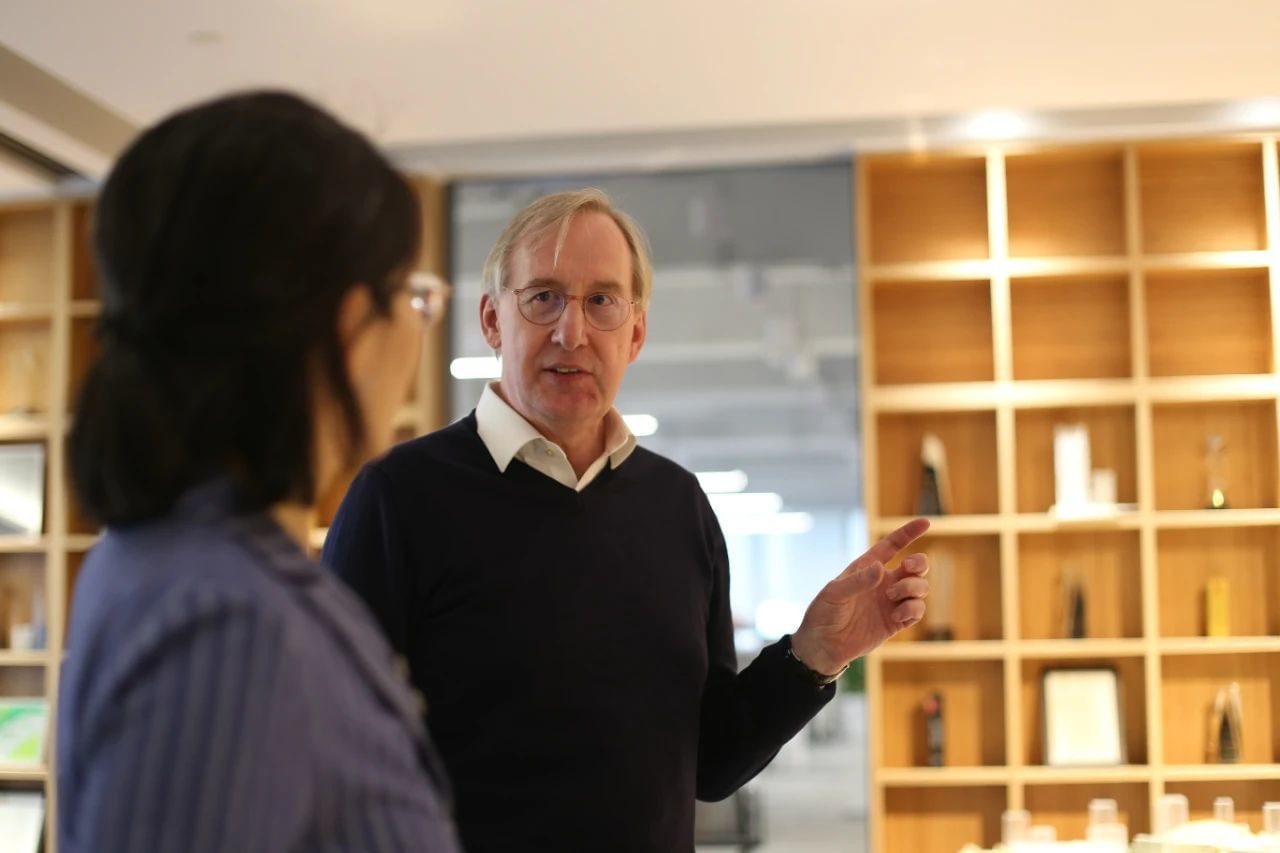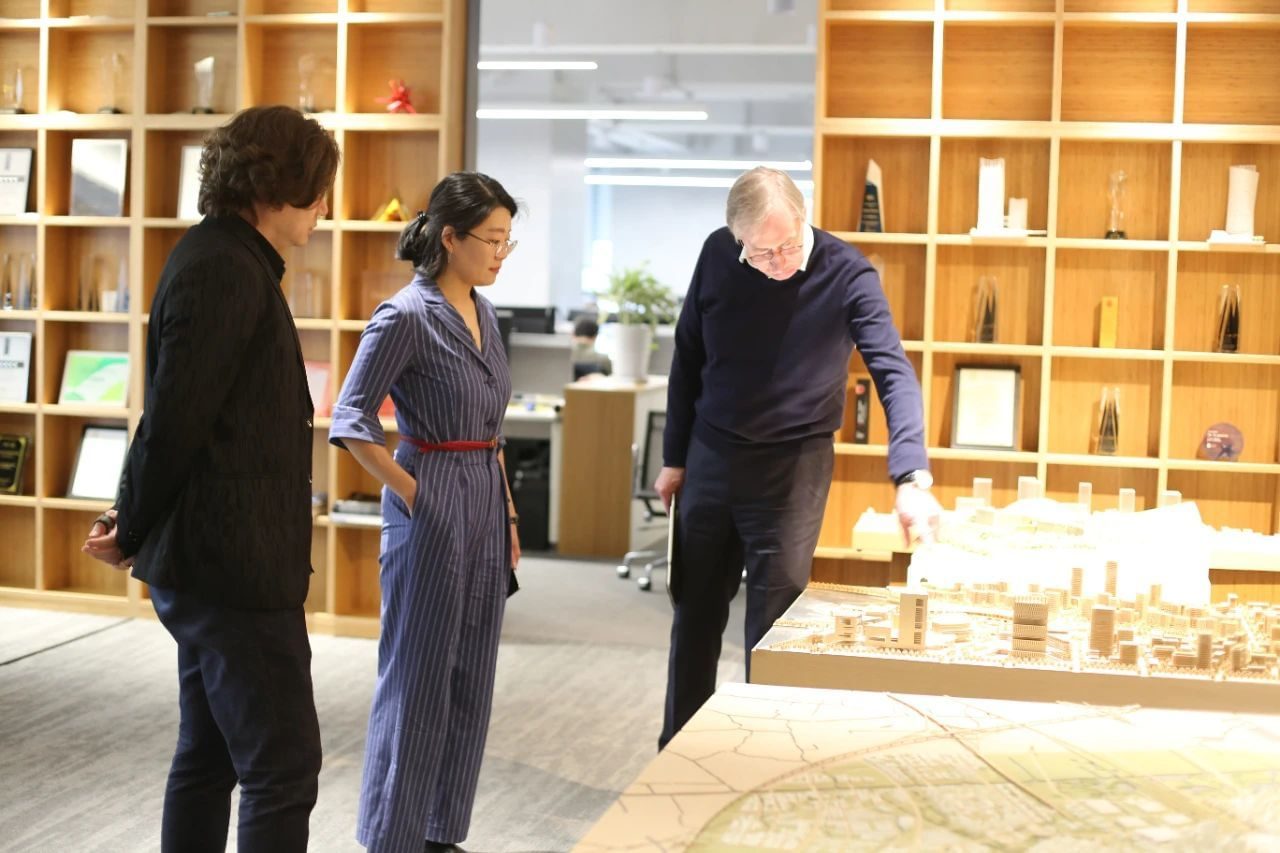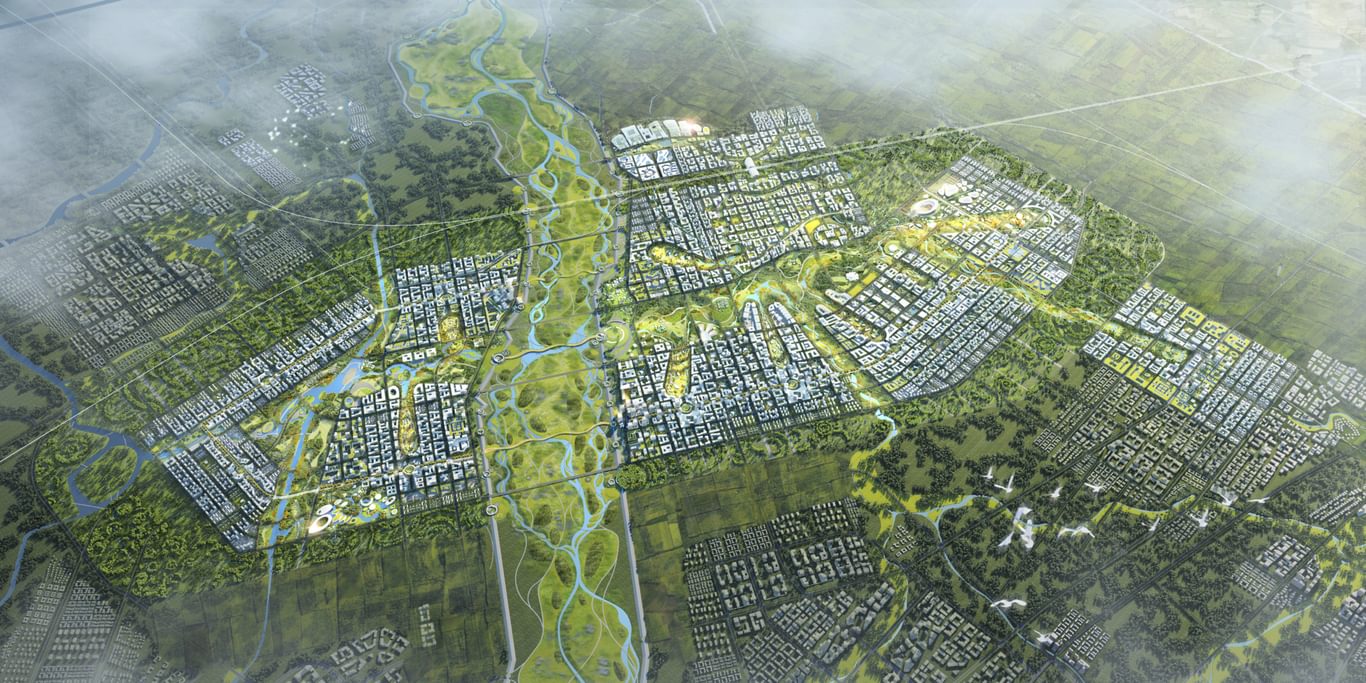
Chapman Taylor interviewed by major architectural media platform “Youth Architects” in Shanghai, China
The history of Chapman Taylor dates back to its founding in 1959. Over the years, the company has consistently ranked among the top 50 of the world's top 100 architectural design companies. Their design work spans across more than 100 countries worldwide, showcasing their global presence and influence in the architectural industry.
In 2007, Chapman Taylor established its Shanghai Studio, which now boasts a 16-year history. During this time, the studio has been involved in various notable projects, including the Global Harbor series and the masterplanning of the Xiong'an Xiongdong and Zangang areas. Additionally, they have completed over 100 high-quality projects, solidifying their reputation as a reputable and successful architectural firm in China.
"Youth Architects" interviewing Chapman Taylor
"Youth Architects" is one of China's top 3 architectural information media platforms. With a comprehensive business scope that encompasses news, interviews, overseas study tours, recruitment, and company promotions. They primarily utilise their WeChat account as their main communication channel and on a daily basis, "Youth Architects" attracts a significant audience, with their daily page views ranging from 10,000+ to 20,000+ people.
In a recent interview, the team from "Youth Architects" conducted an exclusive visit to Chapman Taylor's Shanghai Studio. During the visit, they had the opportunity to conduct interviews with prominent figures, including Chris Lanksbury, an International Director of the company, and Jiang Yi, the Director of the Shanghai & Beijing Studios. This exclusive interview shed light on Chapman Taylor's development history and its approach in both the Chinese market and the global architectural landscape. Furthermore, the interview explores topics related to the impact of AI technology on the architecture industry and the enduring advantages of human architects in the face of technological advancements.
1. Tell us about your company history?
Chris: The company was founded by three people, two men and a woman. One was Bob Chapman, the other was John Taylor, and the third was Jane Durham.
Chapman was a versatile architect with strong skills in both design and construction techniques. Taylor was a charismatic person who was good at networking. Durham worked with me for many years, and she was very knowledgeable about building technology and excellent at financial management. Therefore, like many successful companies, the three founders had compatible strengths and distinctive features that created a balanced architectural practice.
From its inception to the present day, the company has gone through several generations of leadership changes, but the characteristics of the founders and the core philosophy of the company at its inception have remained unchanged. That is, to create beautiful spaces for cities and build high-quality buildings for people, to hire the most professional staff, and to create an environment for architects to be creative.
For many years after its establishment, the company primarily undertook work in London, with project types including high-end residential and large-scale real estate masterplanning, as well as some major office developments. Later, its business expanded gradually to various parts of the world, covering the mixed-use, retail, leisure, workplace, and hospitality sectors.
Johnny: I knew from the beginning that Chapman Taylor focused on cooperation, which is one of the things I like about the practice, noting that it was founded by architects from different backgrounds who complemented each other's strengths. Before joining Chapman Taylor, I went to the UK to see some of their completed projects, and I was highly impressed.
2. What is unique about Chapman Taylor?
Chris: We all have varying perspectives within a similar framework. There are similarities and differences among international architecture firms. From my observation, Chapman Taylor is a very collaborative design company. We listen carefully and respond actively to clients, users, partners, colleagues, and so on, which is a very important and advantageous aspect of our work. We also pay great attention to our client’s aspirations, as well as the dialogue between architecture and the context of any project.
We are also a very diverse company where everyone is encouraged to express their views. We do not give orders from top to bottom. We set basic values and a design process that should be followed. People from different studios around the world can explore their own ideas freely under these basic principles. From a single building to a city plan, we create projects with a wide variety of characters, which are highly responsive to the place and program.
This means that when browsing our work, it is clear that they are tailor-made for each situation. This is also the reason why I like to work around the world, to communicate and collaborate with different people, and to meet the needs of various cultures. I am concerned not only with the final presentation but also with the process and interaction.
Johnny: I joined CT in 2018. I think a very important advantage of CT is its "localised" design philosophy. All projects must be unique and customised for each client. This is very much in line with my own design philosophy. If a project can be replicated on other sites, the design itself may be problematic.
I think another important advantage of Chapman Taylor is its comprehensive range of capabilities, including urban design, masterplanning, Transport-Orienated Developments (TODs), mixed-use design, interior design, etc. It also advocates the careful integration of these different sectors and services. Chapman Taylor's wide experience allows us to adapt to different regions and meet the needs of a variety of clients and users.
3. Tell us about Chapman Taylor's global development?
Chris: In the 1980s, Chapman Taylor's growth in the UK was very strong, mainly due to the booming urban development and reconstruction at that time. We focused mainly on complex commercial projects and won 80% of the design competitions we entered, which formed an outstanding reputation and brand influence in this field. Gradually we accumulated achievements and capital to expand into overseas markets. The company's business grew steadily, and we were careful not to expand rashly. Initially, we entered the French-speaking markets in France and Belgium, and then gradually expanded to other regions in Europe. The cultural differences between the UK and other parts of the world can be significant, but by research, understanding and collaboration we have continued to be successful in many different places.
Chapman Taylor first came to Shanghai in 1996 and participated in a project on Nanjing West Road. This was at the time of the Asian financial crisis, so during that time, before moving to China in 2007, we focused more on other markets. Looking at the world today, the Middle East, particularly Saudi Arabia, has major growth potential and many extraordinary projects are being designed there.
Chapman Taylor adjusts to market changes within the global economy, noting that real estate conditions can fluctuant with peaks and troughs. Therefore we require rigorous corporate management structures to enable the company to grow and develop in a stable way.
4. How does Chapman Taylor choose which markets to expand into?
Chris: Our fundamental principle for choosing and developing a new market is based on people, it is not simply about following projects. Rather it is about selecting the right people to join our team and gradually root ourselves in the local market. After all, we are not AI, but rather a business composed of like-minded people. We recruit architects who are familiar with the local conditions and have strong BD, management and design skills. Moreover, we respond quickly to customer needs by setting up studios, integrating them into the local circumstances with an international vision and standards. Our strategy is to have a long-term commitment to our projects and the countries we work in.
Today, the architectural world is becoming increasingly competitive. In the post-pandemic era and combined with the financial crisis, the industry is challenging globally. To win projects we need to produce high-quality designs to compete, and this is the most important part of what we do.
So, everything goes back to the ability of our people. Whether the team is in London or Shanghai, ultimately, it is the right people following similar design principles and paths, collaborating together to create good design. Our staff in China have benefitted from the significant pace of developments and construction projects in China in recent years, and design quality has also been exponentially improving. We are now involving the Chinese team on international projects and they can explore the world from their own perspectives.
5. Tell us about Chapman Taylor's growth in China and your recent Chinese design projects?
Chris: In 2007, we established our first office in Shanghai, located in a warehouse building next to the Suzhou River. At that time we did a lot of interior design for retail and office spaces and steadily developed our business. With the gradual establishment of our brand and reputation, we began to participate in more complex mixed-use developments and later entered into major city masterplanning, which are also the type of projects that I am personally most interested in.
In the past five to six years, we have had an advantage in the field of mixed-use commercial complexes, not only in Shanghai but also in many other parts of the country. Although our development in the Chinese market has had its ups and downs, overall, the situation is very good and very encouraging. We feel the welcoming nature and tolerance of the Chinese market, which is also an important component of Chinese culture in my opinion. China wants to interact with foreign countries and uses this as an important driving force for the development of its own culture, learning from the outside while not losing its own very strong foundations.
Johnny: The first project I was involved in was the design of Zhangjiang IC Design Industrial Park Block 2B-6. This project is located in the core area of Zhangjiang High-tech Park in Pudong. The project also includes the first Indigo hotel located in Pudong. It was won through a highly competitive international competition, and the competitors were all top international design teams.
In fact, throughout Chapman Taylor's development history, the biggest source of our projects has been through competition wins, especially in recent years. We have learned a lot from our competitors, as well as from collaborating with large design institutes, academicians, and local design firms.
Another current representative project is the Tianjin South Railway Station area, which is different from most TOD projects. It is related to urban renewal and also involves the transformation of an old station and the creation of a new station. The effective combination of different city functions is like a precise surgical operation, which I find very interesting.
6. Does Chapman Taylor want to design landmark buildings in your projects?
Chris: The situation varies for each project and depends on the conditions of the location and the brief. For example, in the UK you typically wouldn't focus on creating landmark buildings, but rather blend in with the urban fabric and integrate into the city, which is a very British design attitude. Of course, London does have landmarks, but most projects don't emphasize landmark status.
However, we are currently designing a comprehensive art museum in a very important city centre location in Kazakhstan, where the design is intended to highlight landmark status rather than blending in with the city.
Therefore, we carefully respond to the design requirements of each project. Generally speaking, it is difficult to simultaneously design landmark buildings and blend into the city, and the choice depends on evaluating the local and project-specific factors at that time. If a building is carefully integrated with the urban fabric, it can also be an example of excellent design.
Almaty Museum of Arts in Kazakhstan
7. What advantages does Chapman Taylor have as an international design firm compared to local design agencies?
Chris: I don't like comparing "local" and "international" design firms. Although we have been involved in projects in more than 100 countries, it doesn't mean we know more than local architects. Local architectural firms have a deeper understanding of the context, and what we do is bring a different perspective and understanding of the same things, which may collide and inspire more unique ideas, creating a diverse city together.
For example, I am fascinated by Chinese culture. In the UK, many people have lost their sense of history or rather the sense of history is changing. It was very encouraging that when designing urban-scale projects in China, all the team members have rich historical knowledge, including an understanding of the different regional cultural elements for each project. It is important to incorporate this knowledge into contemporary projects to create continuity and relevance of place.
During the pandemic, when I was communicating with the Chinese team from our London studio, each team member expressed their views like being part of a BBC documentary, which was very entertaining and instructive. I imagine this is due to the solid education system in China. In addition, some of our team members have also received education overseas, and this combination of international perspectives with domestic understanding provides depth to our creativity.
There are many excellent architects in China producing very good work. What is slightly lacking is the promotion of their successes internationally. It would be great if the best Chinese architects and architecture was presented more vigorously in the UK and Europe.
This does not conflict with Chapman Taylor's positioning in China. As mentioned before, Chapman Taylor does not have the superiority of an international architectural firm, we provide a different perspective. We carefully integrate our design concepts within different cities and aspire to design buildings that have a positive dialogue with urban environments.
8. Has Chapman Taylor changed the types of projects it works on in response to market conditions?
Johnny: Currently, we still focus on the same sectors we have always worked in, these include large-scale commercial mixed-use projects, TODs, urban planning, as well as office industry parks, hotels, and other special projects.
Sometimes we also participate in cultural buildings, and we enjoy designing small and large-scale projects.
Regardless of the size of the project, we always explore the relationship between people and the city, and each project is a unique and customised creation that belongs exclusively to the site and the needs of the client. This is the strategic direction we are committed to.
9. How does Chapman Taylor implement sustainability?
Chris: We place great importance on the concept of sustainability. It is a complex issue that goes beyond just energy conservation, which is why we have established an approach called Responsible Design. This promotes the research and development of a knowledge system that our designers can understand and incorporate into our work including addressing various climate issues and challenges faced by different regions, such as droughts, floods, and the application of automation and digital twin technologies to provide possibilities for social and energy management, creating smart cities, and adopting different design strategies to suit different regions.
Creating quality spaces is also a reflection of our design responsibility. Every site has different stakeholders competing for space and resources, creating a complex situation. Designers need to balance the demands of various parties and create usable and attractive spaces, such as the plaza outside our office in Shanghai where children play and older ladies dance in the evenings. They do not realise that these spaces are specifically designed for them, but they instinctively enjoy them as an important part of the city environment. We hope that the places we design become an integral part of the community and that they are a component of a varied and diverse urban structure.
10. Do cities need to be designed beautifully?
Chris: Cities don't need to always be beautiful, because if all cities were like Rome, people would suffer from visual fatigue. We also need industrial cities, with sturdy buildings that may not be beautiful but should have a strong sense of place. We strive to create cities that are social places, with an emphasis on pedestrianisation, with a balance between vehicles and people.
All cities have their own personalities. These different characters come together to create the diversity of cities. There are so many wonderful cities in the world, and each city has something for us to learn from.
11. What kind of spaces do you hope to create?
Johnny: I think first of all, projects should have a unique design, whether it is a building or a space; secondly, it should sit comfortably in its surroundings. The building doesn't need to be the centre of attention but should serve as a background to people's lives. Buildings should integrate with the urban space, and have a positive dialogue with it.
12. What is your view on the impact brought about by the rapid development of Chinese cities?
Chris: The current era has developed at an unprecedented pace, with a huge amount of urban construction, which poses challenges that have never been seen before. It is not only about building construction, but rapid development also involves economic, industrial, and employment factors, all of which are interrelated, correlated, and superimposed, ultimately forming a very multi-layered city.
For example, for our Xiong'an project, the government and different stakeholders had different priorities, such as the high-intensity development of the economy, the focus on environmental space, or low-density development. Moreover, cities are the result of time accumulation and gradual growth and maturation, rather than satisfying everyone's needs immediately. During the post-industrial period, many European cities experienced demolition and barbaric growth, with poor planning and architectural quality. Through economic and urban regeneration, they are gradually regaining vitality.
I believe that China will face a huge urban renewal stage, transforming and reshaping the cities. After more than 20 years of development, the tasks we encounter in the current projects we participate in are generally reasonable, indicating that they have been carefully considered and fully balanced from various perspectives such as the economy and employment. The design of cities should be based on solid research, a strong vision, and an optimistic attitude. This will ensure our future cities will be even more diverse and livable.
13. What changes are currently happening in China's real estate market industry?
Johnny: The architectural landscape has witnessed noticeable changes in the past two years, signifying a shift in the types of projects undertaken and the factors considered during the development process.
Previously, developers held a considerable number of projects and exhibited extensive experience in project operations, meticulously divided into specialised roles. However, their primary focus was on commercial logic and profit-driven outcomes, leading to substantial pressure on industry stakeholders to deliver these objectives.
In recent times, the dynamics have evolved, and there is a notable increase in projects originating from state-owned enterprises and government platforms. These entities exhibit a different approach, emphasising not only economic gains but also giving significant attention to social factors, particularly the urban environment. This new perspective underscores the importance of projects that benefit society at large, thereby aligning with broader urban development goals.
14. How did you decide to become an architect?
Chris: As a child, I lived in Bath, an ancient city located in the west of England. The city is famous for its mineral-rich hot springs that historically attracted wealthy people for vacations, resulting in the construction of many beautiful classical buildings. I myself lived in a very famous 18th-century street called The Circus. Because of this since the age of nine, I aspired to become an architect, surrounded by such an environment where beautiful buildings were ubiquitous, and even ordinary people were well-versed in architectural aesthetics.
My father was in the Navy and a skilled artist. Although we moved to many cities, the artistic atmosphere in our family and the appreciation for beautiful architecture was always present. My parents often took me to visit art galleries and museums in different places. All these experiences naturally shaped my personality and led me to the path of architectural design.
Johnny: I also loved drawing since I was a child. I grew up in a university environment where many of my relatives were professors in design-related fields. So, I was surrounded by an artistic atmosphere. Later in my academic career, I studied majors related to art. I think architecture is a profession that I can continuously improve in throughout my entire life.
Architecture has also taught me a lot, or rather, it has become a way of life for me. Like Chris, my work and life are inseparable. Even when I stop to do other things, my brain is always thinking about unfinished projects.
15. Is it time to slow down development?
Chris: My hometown of Glasgow in Scotland is a city with a long history but many of its wonderful historic buildings were demolished. It was understood too late that many had the potential to be protected and regenerated. In Shanghai, we can see many old urban areas that have the potential to be revitalised after improvement, and result in a more layered and interesting urban character.
Johnny: I feel the same way. Cities can develop too quickly, and the places and environments where we used to live, those memories are nowhere to be found. In the past few decades, compared to Europe, our time has gone too fast, and slowing down a bit may not be a bad thing.
16. Can Artificial Intelligence (AI) replace Architects?
Chris: Humanity does indeed face significant challenges. For example, what made humans unique was our propensity to make mistakes, learn from them, and develop personality and character. Apparently, AI can also learn from mistakes, self-iterate, and develop its own personality. This imperfection can actually lead to interesting and creative results. The development of AI technology has sparked a lot of discussion and debate about its pros and cons, with different perspectives.
The development of AI not only affects the architecture industry but also society as a whole. I believe that we should actively embrace it and face all the challenges that come with it because it is truly incredible. We need to understand the development of society and learn from it, rather than ignoring the changes brought about by technological advances. One great thing about design is that we don't only use one tool to create our work, we need to master many different production methods, from hand drawing to sophisticated technologies.
Architectural design also involves social interaction. Clients still prefer face-to-face communication with architects to discuss the project. This represents a commitment by the architect to the project, and clients can understand the architect's personality and character and hope to establish long-term cooperative relationships and gain peace of mind. Architects can in turn clearly understand the owners' expectations and vision for the project. Perhaps in the future, algorithms will complete the design process, but it appears that it will be a while before machines can completely replace architects.
In addition, great architects are usually very good at communication, which is in a sense a form of sales. Using language to describe your design is crucial for architects.
17. What would you say are your strengths?
Chris: I am good at integrating into a team and forming productive collaborations to create high-quality design work.
Johnny: I personally feel that I am still a design architect. As the team grows, each person has their own strengths and weaknesses, so I have to balance everyone's abilities. I also have to consider market development, team management, brand promotion, and so on, but I am also working hard to find passionate team members, to get everyone involved in what we are doing. I have also learned a lot from Chris, who has a professional, open, and inclusive attitude. We are still most importantly designers of buildings and spaces.
18. Finally, do you have any advice for young architects?
Chris: I believe that architects still need to maintain optimism. There are still many opportunities in the architecture industry. When I first started working, there were only pens, but now there are multiple design technologies and software available. Architects should fully embrace technology, learn and understand it, and guide technology instead of being guided by it. Perhaps with the development of AI, simple design ability will gradually change, but architects still need to understand the language of architecture and write it into the system to generate designs, which still requires a design process. In the future, language skills may become even more important.
Architecture is not just about design, but also about marketing, promotion, and collaboration. Excellent architects are everywhere, not just sitting in the studio designing. They need to go out, promote their ideas, participate in competitions, stand out from the crowd, either by doing it themselves or with a strong team. Finding like-minded collaborators with a common vision and developing good teamwork, coordination, and a balanced set of skills is vital. Perhaps times have changed, but being an architect has never been a profession that can be done well with only one skill.
Johnny: It is important to maintain a thirst for knowledge. The skills required of architects vary from era to era. AI now creates buildings that belong to this era. However, traditional concepts, including hand drawing, still have their own value. Take the Japanese architect Kiyonori Kikutake, for example, his work has a perfect sense of scale that touches people's hearts. When I looked up his information, I found that he still doesn't use a computer and only relies on models and hand drawing to do his design work. Therefore, software is just a means. Moreover, I believe that machines learn from us, so can't we also learn from them? Because the human brain has unlimited potential, we can use this opportunity to further develop ourselves, rather than just relying on machines to extend our abilities.






